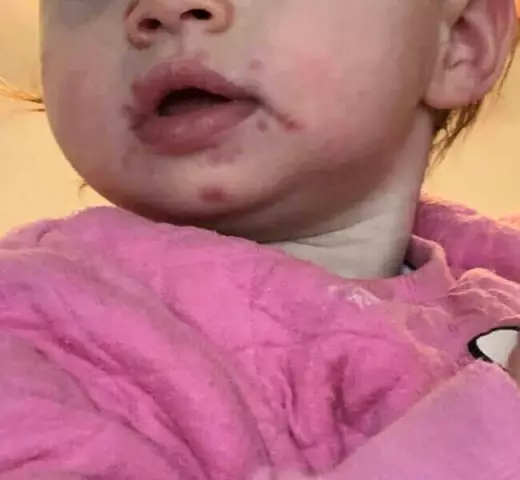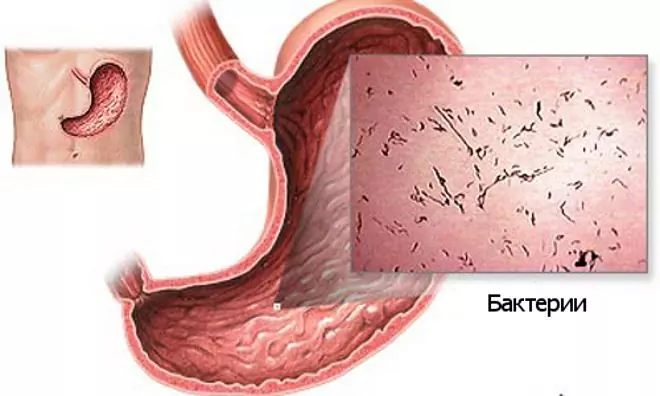- Author Rachel Wainwright [email protected].
- Public 2023-12-15 07:39.
- Last modified 2025-11-02 20:14.
Treatment of herpes in children

Treatment of herpes in children should be under medical supervision. The fact is that therapy is used mainly in severe cases, when the child's immune system cannot cope with the virus. If everything is in order with immunity, it is better to do without medications. Therapy is usually based on diagnostic results and is complex. The main role in the treatment of herpes on the child's body is assigned to antiviral and immunomodulatory drugs, as well as interferon inducers and topical drugs.
Treatment of herpes on the lips of a child
Usually, herpes on the lips of a child does not require treatment. This is a type 1 virus, which is carried by 95% of people. It usually enters the body in early childhood and remains in the cells of the nervous system for life. Periodic relapses in the form of bubbles most often occur on the lips due to stress or weakened immunity, although in all people herpes is provoked by different reasons.
The question of why exacerbations do not occur in all infected people is still open in medicine. If one of the parents activates the virus at least once a year, while the other does not, then there is a high probability that the antibodies will be inherited by the child. Thus, the herpes simplex virus, which can spread both through domestic use and through the air for hundreds of meters, will not cause any symptoms in the child.
But even in this case, so that children do not need treatment for herpes, Komarovsky advises to adhere to certain safety measures. In particular, parents or other people, both adults and children, with acute herpes should not have close contact with healthy children. This is due to the concept of viral load, which is determined by the number of viral particles in the infected body and affects the severity of the viral infection.
This means the following: for example, a child in kindergarten touched the bubbles on his lips and, without washing his hands, took a toy. When the same toy gets to a healthy child, he may not "catch" herpes, because his immunity will cope with a low viral load. But if a mom or dad with a "fever" kisses him, then the number of transmitted particles will multiply and the infection will take place, despite the presence of antibodies.
Treatment of herpes in children is effective only when the very first symptoms appear:
- Burning sensation;
- Tingling;
- Slight pain.
If a child begins to complain of such sensations, then a special ointment should be used immediately to stop the disease at the very beginning. If this does not work, then soon there will be inflammation and swelling with many bubbles filled with fluid. From this moment until the signs of herpes completely disappear, every 3-4 hours it will be necessary to apply an ointment containing acyclovir - the only antiherpetic agent safe for children.
Over time, the bubbles will start to burst. This is the most contagious period for others, so it is better to apply the ointment with a cotton swab, and not with your hands. Subsequently, the ulcers formed are healed and covered with a crust that cannot be peeled off, since there is a risk of infection.
The feasibility of treating herpes in children and the dosage of medications should be discussed with your doctor.
Treatment for herpes zoster in children
With herpes zoster, treatment of children must be started within 3 days from the onset of the first rash and continue for 2 more days after its disappearance. Timely prescription of drugs containing acyclovir reduces the duration of the disease and promotes the rapid formation of crusts. The sooner the parents start treating herpes on the child's body, the less severe the symptoms will be. In addition, the likelihood of complications will be significantly reduced.
If the disease is not severe, then acyclovir is taken orally 5 times a day, 800 mg. In complicated forms, ribamrin is administered at the rate of 15 mg / kg within 12 hours.
Therapy can also consist in a single use of immunoglobulin in an amount of 0.2 ml / kg. In rare cases, this dosage is increased by 2-4 times. Along with general antiviral agents, ointments with acyclovir or interferon are prescribed.
It must be remembered that with prolonged use of the same drug, the virus develops resistance to the active substance. For this reason, no later than 10 days later, the doctor must prescribe another drug.

Pain syndrome is reduced with the help of non-steroidal anti-inflammatory drugs, tranquilizers, novocaine blockades. Perhaps the appointment of electrophoresis or ultraviolet irradiation of the affected areas.
Komarovsky speaks about the principles of treating herpes in children as follows: first of all, it is important for parents to monitor the child's immunity; in case of a severe course of the disease, it is necessary to contact a pediatrician who will decide the question of the advisability of drug therapy. In most cases, if the child is generally healthy, no unpleasant consequences should arise.
When scabs form, itching appears, so you need to make sure that the child does not scratch the rash, risking an infection. Antihistamines can be used to relieve itching, but you should also consult your doctor about using them.
There is no vaccine for all types of herpes. Today only vaccination against chickenpox, which is one of the varieties of herpes, is effective. It should be done to prevent complications such as chickenpox encephalitis. Even if the child has already had chickenpox, the vaccine will prevent shingles from recurring.
Found a mistake in the text? Select it and press Ctrl + Enter.






